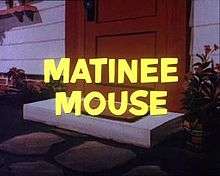Matinee Mouse
| Matinee Mouse | |
|---|---|
| Tom and Jerry series | |
 Title card of Cat and Matinee Mouse | |
| Directed by |
Main: William Hanna Joseph Barbera Story Directed and Supervised by: Tom Ray Title director: Chuck Jones (uncredited) |
| Produced by |
Chuck Jones Metro-Goldwyn-Mayer (uncredited) Tom Ray (production supervisor) Fred Quimby (uncredited) William Hanna (uncredited) Joseph Barbera (uncredited) |
| Story by |
William Hanna Joseph Barbera (both uncredited) |
| Voices by |
Mel Blanc (uncredited) William Hanna (uncredited) |
| Music by | Dean Elliott |
| Animation by |
Kenneth Muse (character animation) Ed Barge (character animation) Irven Spence (character animation) Ray Patterson (character animation) Lewis Marshall (character animation) Philip DeGuard (additional background paint) Al Grandmain (effects animation - uncredited) Robert Gentle (background paint - uncredited) Richard Bickenbach (character and background layout - uncredited) Ken Harris (title character animation - uncredited) Grant Simmons (additional character animation - uncredited) Don Patterson (additional character animation - uncredited) Ernie Nordli (additional character and background layout - uncredited) |
| Studio | MGM Animation/Visual Arts |
| Distributed by | Metro-Goldwyn-Mayer |
| Release date(s) | July 14, 1966 |
| Color process | Metrocolor |
| Running time | 6:07 |
| Language | English |
| Preceded by | Filet Meow |
| Followed by | The A-Tom-Inable Snowman |
Matinee Mouse is a 1966 Tom and Jerry cartoon, acting as a compilation film short, featuring clips from a number of older episodes from the Hanna-Barbara era. The story was supervised by Tom Ray, while William Hanna and Joseph Barbera received a special director's credit on the cartoon, though they did not do any actual work on it (other than the clips from the earlier shorts). It is the only Sib Tower 12 Tom and Jerry cartoon that features Spike & Droopy (cameo).
In this short (and the following compilation short, Shutter Bugged Cat), Tom and Jerry are animated using their original designs rather than the designs used in the Chuck Jones shorts. Due to the differences in color processing and animation styles though, the changes between the Hanna/Barbera footage and the Tom Ray footage are not entirely seamless.
Plot
Tom chases Jerry all over the house (clips from Love That Pup, The Flying Cat, Professor Tom, and The Missing Mouse) until Jerry gets back at Tom by beating him up to a pulp in the closet and throwing him out (which was a clip from Jerry and the Lion). Tom begs for mercy as they both call a truce with white flags, both become even and started to walk happily along down the street, they stop by the local cinema, where they both notice a poster advertising their cartoons (implying that Tom and Jerry have occupations as actors). The man who was standing by the wall noticed this cat and mouse. He looks up at the poster, then shrugs.
They walk in to watch the feature (clips from Love That Pup, Jerry's Diary, The Flying Sorceress, and The Truce Hurts), but every time they get thwarted or attacked in the movie, they always begin laughing, but can't stop and then start beating up each other. Mild annoyance soon turns to violence in the seats, where Tom and Jerry continually slam the seats on each other. Eventually, Jerry tears apart his flag (with Tom following suit) before hitting Tom with a xylophone mallet. The movie keeps the characters fighting until the characters in the fighting clip in 1948's The Truce Hurts stops as the onscreen characters (Tom, Jerry, and Spike the bulldog) pause their fight to watch Tom and Jerry in the audience fighting out in the seats and then the short ends. Then the cartoon ends with a two-toned, lower-case "the end" on a black background (the is purple, end is yellow).
Crew
- Story Line: Jim Ryan
- Animation: Irven Spence, Ed Barge, Kenneth Muse, Ray Patterson, Lewis Marshall
- Layout: Dick Bickenbach
- Backgrounds: Robert Gentle
- Directed by: William Hanna and Joseph Barbera
- Music: Dean Elliott
- Additional Backgrounds: Philip DeGuard
- Sound Editing: Lovell Norman
- Produced by: Fred Quimby and Chuck Jones
- Story Directed and Supervised by: Tom Ray